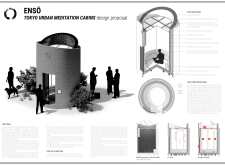5 key facts about this project
The Tokyo Urban Meditation Cabins design proposal responds to the needs of city dwellers looking for quiet moments amidst the lively environment of Tokyo. These cabins focus on providing spaces for reflection and meditation, taking inspiration from the Enso, a symbol linked to Zen Buddhism. The overall design emphasizes harmony and simplicity, aiming to create a peaceful atmosphere for users.
Design Concept
The layout of each Meditation Cabin features circular patterns that align with Zen principles, promoting a natural flow throughout the space. This design encourages individuals to engage in meditation within a calming and visually appealing environment. The minimalist style removes unnecessary distractions, allowing the user’s experience to remain central.
Material Selection
Material choices are key in shaping the cabin’s character and functionality. A 3mm metal covering provides strength and durability. Solar foil from Heliatek and Kaneka supports sustainable energy use within the cabin. Sound-insulating glazing, specifically Trosifol® SC, helps to block out the outside noise of the busy city, creating an ideal space for quiet reflection.
Interior Design
Interiors emphasize comfort and practicality. A round bench with built-in storage accommodates personal items and communal cushions, combining functionality with simplicity. Soft lighting comes from backlit, tear-resistant shoji paper that lines the walls, enhancing the gentle atmosphere. Metal guide rails maintain the design’s clean lines while ensuring everything fits together well.
Operational Functionality
In each cabin, automated skylights provide ventilation, keeping the environment fresh and comfortable for users. The entrance door opens automatically, making it easy for people to access the space without noise interruption. This thoughtful approach to both technology and design allows individuals to enjoy the cabin experience fully, focusing on their meditation without distractions.
Overall, the design balances form with practical needs. It creates a space where individuals can escape from the pace of city life and engage in their own moments of tranquillity.



















































